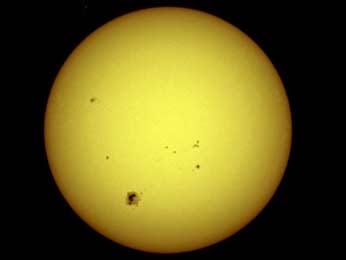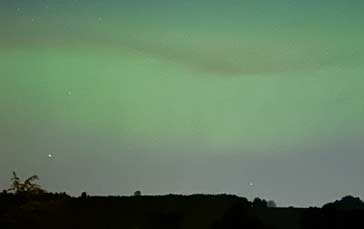Solar Indices: Solar Flux A K Kp Index
As the radiation from the Sun is the major influence on the ionosphere, solar indices including the solar flux, A index, Ap index, K index and the Kp index are all important in predicting the state of the ionosphere and HF ionospheric radio propagation.
Home » Antennas & Propagation » this page
Ionospheric propagation tutorial includes . . . .
Ionospheric propagation
Ionosphere
Ionospheric layers
Skywaves & skip
Critical frequency, MUF, LUF & OWF
How to use ionospheric propagation
Multiple reflections & hops
Ionospheric absorption
Signal fading
Solar indices
Propagation software
NVIS
Transequatorial propagation
Grey line propagation
Sporadic E
Spread F
Solar aspects:
Solar effects on radio propagation
Sunspots
Solar disturbances
SID sudden ionospheric disturbance
Auroras & propagation
As electromagnetic waves, and in this case, radio signals travel, they interact with objects and the media in which they travel. As they do this the radio signals can be reflected, refracted or diffracted. These interactions cause the radio signals to change direction, and to reach areas which would not be possible if the radio signals travelled in a direct line.
Ionospheric radio propagation is notoriously changeable. However for many applications radio propagation prediction is necessary. For example for broadcasting as well as for users of two way radio communications links that utilise the HF bands as well as mobile radio communications, maritime radio communications, and many other point to point radio users, a knowledge of the propagation patterns that will be in existence at a particular time are almost essential. In this way radio communications users who require propagation via the ionosphere can choose the best times and frequencies in which to establish their radio communications.

Image Coutesy NASA
Radio propagation prediction
There are many indicators that enable the HF radio propagation conditions to be predicted. However it is indicators of the level of solar radiation and geomagnetic activity that give the best clues to the possible state of radio communications propagation conditions via the ionosphere. The main solar indices are the solar flux and the geomagnetic indices known as the A and K indices. Using these it is possible to manually deduce what conditions may be like. However there several packages of radio propagation prediction software that are available. These take the various indices into account along with the position on the globe, time of day, season, and the position in the sunspot cycle.
Solar flux
One of the major indicators of solar activity used for radio propagation prediction is known as the solar flux and it has a major impact on radio communications propagation conditions. It provides an indication of the level of radiation that is being received from the Sun. This solar index is measured by detecting the level of radio noise emitted at a frequency of 2800 MHz (10.7 cms). The index is quoted in terms of Solar Flux Units (SFU). An SFU has the units 10-22 Watts per metre2 per Hz.
The level of solar radiation varies around the globe. Even when correction factors have been applied it is not easy to be able to provide a consist series of figures. To overcome this, the standard is taken as the reading from the Penticton Radio Observatory in British Columbia, Canada. Thus these figures are of great interest for ionospheric radio propagation prediction.
The level of ionising radiation that is received from the Sun is approximately proportional to the Solar Flux. There is a statistical relationship rather than a direct one because the level of radio noise received at 2800 MHz is about a million times less in intensity than that of the radiation that creates the ionisation in the ionosphere. However the Solar Flux provides a good first order approximation, particularly for the F region that is responsible for most long distance ionospheric radio communications propagation. The best correlation is with levels of the Smoothed Sunspot Number (SSN).
It is possible to relate the daily sunspot number to the Solar Flux. A number of equations are available but the one given below is straightforward and sufficiently accurate for most purposes:
Where R is the daily sunspot or Wolf number.
A slightly more accurate, although more complicated equation indicates the relationship between the two values is not totally linear.
The values of Solar Flux vary over a wide range. At their lowest (typically during the periods of the sunspot minima) they may be as low as 50 but rise to maximum values of around 300 (around the times of the sunspot maxima).
As the values of Solar Flux provide an indication of the level of ionisation in the ionosphere. In turn this gives an indication of what the Maximum Usable Frequency (MUF) for radio communications may be. Low values of Solar Flux indicate that MUF figures may be low. High values of Solar Flux indicate that the MUF may be higher. It should be remembered that there must be several consecutive days of sustained high solar radiation with the absence of solar disturbances for high MUFs for HF band radio communications.
Geomagnetic indices
Apart from the Solar Flux, another important influence on the ionosphere and hence radio propagation prediction is the level of geomagnetic activity. While the geomagnetic activity is a measure of the state of the Earth's magnetic field, this in turn is influenced by the Sun. To indicate the state of Geomagnetic activity, there are two indices that are used that are related to each other:
- K index
- a Index
Although different, both these indices give indications of the severity of magnetic fluctuations, and hence the level of disturbance to the ionosphere.
K Index
The K index is a three hourly measurement of the variation of the Earth's magnetic field compared to what are "quiet day" conditions. The measurement is made using a magnetometer.
This indicates the variation of the magnetic flux in nanoTeslas. This reading is then converted to the K index. The relationship is quasi-logarithmic, i.e. an almost directly proportional on a logarithmic scale..

The K index is measured at many different places around the world. The magnetic field varies around the globe and accordingly a different value for the K index is created at each measurement station.
Owing to the fact that the magnetic field varies in different ways around the globe dependent upon the way in which the magnetosphere is affected, it is not possible to have a simple relationship between one station and a global K index. Instead the individual K indices are averaged around the globe to give what is termed the Kp or planetary K index.
Kp Index
The planetary or Kp index has values that range between 0 and 9. The values of the kp index give a good indication of geomagnetic activity: values between 0 and 1 indicate quiet magnetic conditions and would give rise to virtually no degradation in HF band radio communications conditions. Values for the kp index between 2 and 4 provide an indication of unsettled magnetic conditions that indicate the possibility of some degradation on the HF bands for radio communications. A value of 5 signifies a minor storm and 6 a larger one. Values through to 9 indicate steadily worsening conditions with 9 representing a major storm that is likely to result in a blackout in HF ionospheric propagation for several hours.
A Index
The A index is a linear measure of the Earth's field. As a result of this, its values extend over a much wider range. It is derived from the K index by scaling it to give a linear value which is termed the "a" index. This is then averaged over the period of a day to give the A index. Like the K index, values are averaged around the globe to give the planetary Ap index.
Values for the A index range up to 100 during a storm and may rise as far as 400 in a severe geomagnetic storm.
A index & Kp index relationship
Although the A index and K index are different values it is possible to relate these indices together. A summary of this relationship is given int he table below.
| Relationship between Kp index and a Index | ||
|---|---|---|
| Ap Index | Kp Index | Description |
| 0 | 0 | Quiet |
| 4 | 1 | Quiet |
| 7 | 2 | Unsettled |
| 15 | 3 | Unsettled |
| 27 | 4 | Active |
| 48 | 5 | Minor storm |
| 80 | 6 | Major storm |
| 132 | 7 | Severe storm |
| 208 | 8 | Very major storm |
| 400 | 9 | Very major storm |
Geomagnetic and ionospheric storms are very closely related. However they are separate effects. Geomagnetic storms relate to disturbances of the Earth's magnetic field, and ionospheric storms relate to disturbances of the ionosphere. However it is found that geomagnetic storms often lead to ionospheric ones, but not on every occasion.
Interpreting the figures
The easiest way to use these figures for radio propagation prediction is to enter them into radio propagation prediction software. This will provide the most accurate prediction of what might be happening. These programmes will take into account factors such as signal paths because some will cross the poles and they will be far more affected by storms that will those across the equator.
However it is still possible to gain a good insight into what the figures mean in terms of radio propagation for all forms of radio communications using ionospheric propagation purely by assessing them mentally. Obviously high levels of solar flux are needed for good radio communications propagation. Generally the higher the flux the better the conditions will be. However the levels need to be maintained for some days. In this way the overall level of ionisation in the F2 layer will build up. Typically values of 150 and more will ensure good HF propagation conditions, although levels of 200 and more will ensure they are at their peak. In this way the maximum useable frequencies will rise, thereby providing good conditions for HF band radio communications.
The level of geomagnetic activity has an adverse affect, depressing the maximum useable frequencies. The higher the level of activity and hence the higher the Ap and Kp indices the greater the depression of the MUFs. The actual amount of depression will depend not only on the severity of the storm, but also its duration.
Having an understanding of the solar indices is of great help when using HF radio communications, be it two way radio communications, mobile radio communications, radio broadcasting or any form of point to point radio communications using ionospheric or HF propagation. It helps with radio propagation prediction and enables a quick assessment to be made of the possibility of communications being disrupted. Also having a general understanding enables any errors in entering data into the programmes to be quickly noted and corrected. In this way it enables the best to be made of the radio communications equipment and the most reliable communications to be obtained.
 Written by Ian Poole .
Written by Ian Poole .
Experienced electronics engineer and author.
More Antenna & Propagation Topics:
EM waves
Radio propagation
Ionospheric propagation
Ground wave
Meteor scatter
Tropospheric propagation
Antenna basics
Cubical quad
Dipole
Discone
Ferrite rod
Log periodic antenna
Parabolic reflector antenna
Phased array antennas
Vertical antennas
Yagi
Antenna grounding
Installation guidelines
TV antennas
Coax cable
Waveguide
VSWR
Antenna baluns
MIMO
Return to Antennas & Propagation menu . . .



